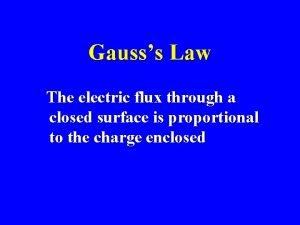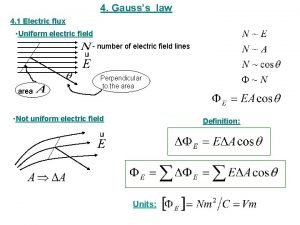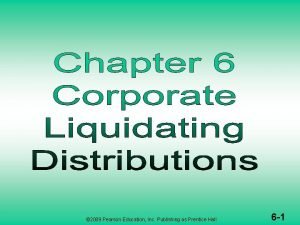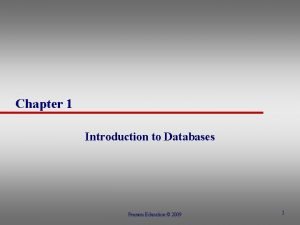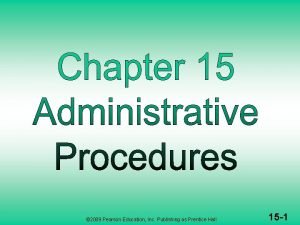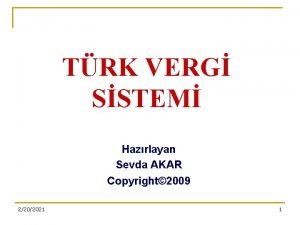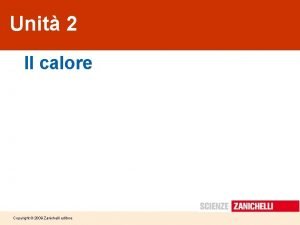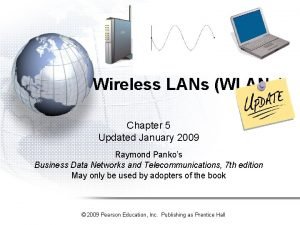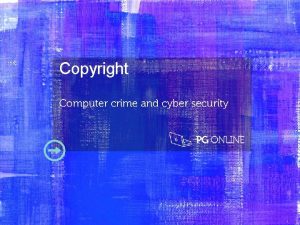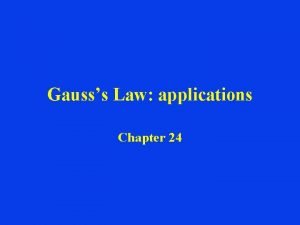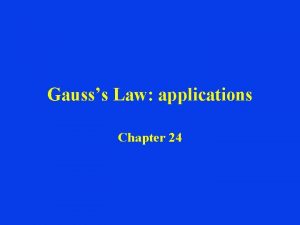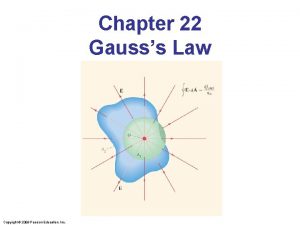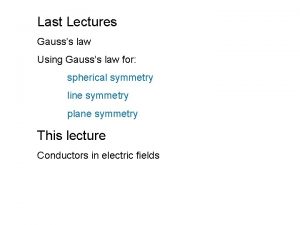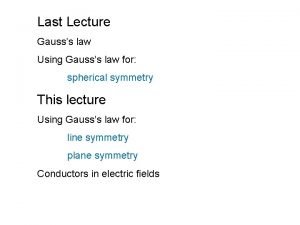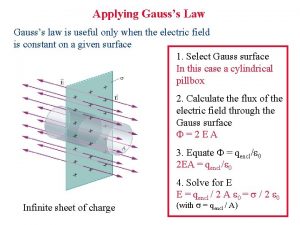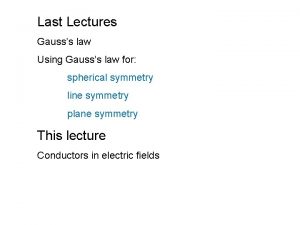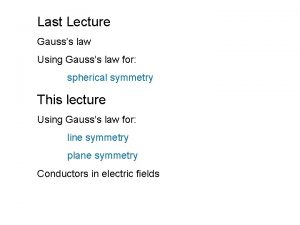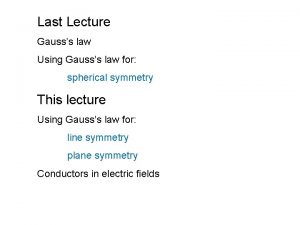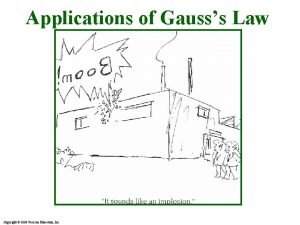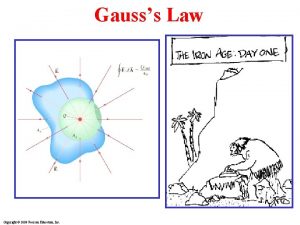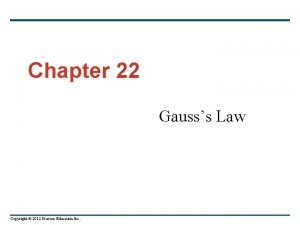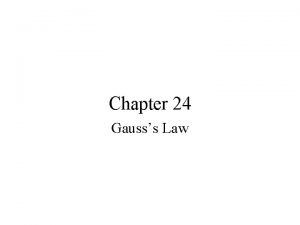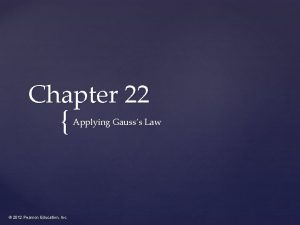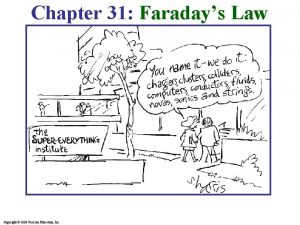Chapter 22 Gausss Law Copyright 2009 Pearson Education






















































- Slides: 54

Chapter 22 Gauss’s Law Copyright © 2009 Pearson Education, Inc.

22 -1 Electric Flux through a closed surface: Copyright © 2009 Pearson Education, Inc.

Think in terms of flux lines: Copyright © 2009 Pearson Education, Inc.

22 -2 Gauss’s Law The net number of field lines through the surface is proportional to the charge enclosed, and also to the flux, giving Gauss’s law: This can be used to find the electric field in situations with a high degree of symmetry. Copyright © 2009 Pearson Education, Inc.

22 -2 Gauss’s Law For a point charge, Spherical Therefore, Solving for E gives the result we expect from Coulomb’s law: Copyright © 2009 Pearson Education, Inc.

22 -2 Gauss’s Law Using Coulomb’s law to evaluate the integral of the field of a point charge over the surface of a sphere surrounding the charge gives: Looking at the arbitrarily shaped surface A 2, we see that the same flux passes through it as passes through A 1. Therefore, this result should be valid for any closed surface. Copyright © 2009 Pearson Education, Inc.

22 -2 Gauss’s Law Finally, if a gaussian surface encloses several point charges, the superposition principle shows that: Therefore, Gauss’s law is valid for any charge distribution. Note, however, that it only refers to the field due to charges within the gaussian surface – charges outside the surface will also create fields. Copyright © 2009 Pearson Education, Inc.

22 -2 Gauss’s Law Conceptual Example 22 -2: Flux from Gauss’s law. Consider the two gaussian surfaces, A 1 and A 2, as shown. The only charge present is the charge Q at the center of surface A 1. What is the net flux through each surface, A 1 and A 2? Copyright © 2009 Pearson Education, Inc.

22 -3 Applications of Gauss’s Law Example 22 -3: Spherical conductor. A thin spherical shell of radius r 0 possesses a total net charge Q that is uniformly distributed on it. Determine the electric field at points (a) outside the shell, and (b) within the shell. (c) What if the conductor were a solid sphere? Copyright © 2009 Pearson Education, Inc. Spherical

22 -3 Applications of Gauss’s Law Example 22 -4: Solid sphere of charge. An electric charge Q is distributed uniformly throughout a nonconducting sphere of radius r 0. Determine the electric field (a) outside the sphere (r > r 0) and (b) inside the sphere (r < r 0). Spherical/radial Copyright © 2009 Pearson Education, Inc.

22 -3 Applications of Gauss’s Law Example 22 -5: Nonuniformly charged solid sphere. Suppose the charge density of a solid sphere is given by ρE = αr 2, where α is a constant. (a) Find α in terms of the total charge Q on the sphere and its radius r 0. (b) Find the electric field as a function of r inside the sphere. Copyright © 2009 Pearson Education, Inc.

22 -3 Applications of Gauss’s Law Example 22 -6: Long uniform line of charge. A very long straight wire possesses a uniform positive charge per unit length, λ. Calculate the electric field at points near (but outside) the wire, far from the ends. Linear, Cylindrical Copyright © 2009 Pearson Education, Inc.

22 -3 Applications of Gauss’s Law Example 22 -7: Infinite plane of charge. Charge is distributed uniformly, with a surface charge density σ (σ = charge per unit area = d. Q/d. A) over a very large but very thin nonconducting flat plane surface. Determine the electric field at points near the plane. Planar & cylindrical Copyright © 2009 Pearson Education, Inc.

22 -3 Applications of Gauss’s Law Example 22 -8: Electric field near any conducting surface. Show that the electric field just outside the surface of any good conductor of arbitrary shape is given by E = σ/ε 0 where σ is the surface charge density on the conductor’s surface at that point. Copyright © 2009 Pearson Education, Inc.

22 -3 Applications of Gauss’s Law The difference between the electric field outside a conducting plane of charge and outside a nonconducting plane of charge can be thought of in two ways: 1. The field inside the conductor is zero, so the flux is all through one end of the cylinder. 2. The nonconducting plane has a total charge density σ, whereas the conducting plane has a charge density σ on each side, effectively giving it twice the charge density. Copyright © 2009 Pearson Education, Inc.

22 -3 Applications of Gauss’s Law Conceptual Example 22 -9: Conductor with charge inside a cavity. Suppose a conductor carries a net charge +Q and contains a cavity, inside of which resides a point charge +q. What can you say about the charges on the inner and outer surfaces of the conductor? Copyright © 2009 Pearson Education, Inc.

22 -3 Applications of Gauss’s Law Procedure for Gauss’s law problems: 1. Identify the symmetry, and choose a gaussian surface that takes advantage of it (with surfaces along surfaces of constant field). 2. Draw the surface. 3. Use the symmetry to find the direction of E. 4. Evaluate the flux by integrating. 5. Calculate the enclosed charge. 6. Solve for the field. Copyright © 2009 Pearson Education, Inc.

22 -4 Experimental Basis of Gauss’s and Coulomb’s Laws In the experiment shown, Gauss’s law predicts that the charge on the ball flows onto the surface of the cylinder when they are in contact. This can be tested by measuring the charge on the ball after it is removed – it should be zero. Copyright © 2009 Pearson Education, Inc.

Summary of Chapter 22 • Electric flux: • Gauss’s law can be used to calculate the field in situations with a high degree of symmetry. • Gauss’s law applies in all situations, and therefore is more general than Coulomb’s law. Copyright © 2009 Pearson Education, Inc.

Chapter 23 Electric Potential Copyright © 2009 Pearson Education, Inc.

Units of Chapter 23 • Electric Potential Energy and Potential Difference • Relation between Electric Potential and Electric Field • Electric Potential Due to Point Charges • Potential Due to Any Charge Distribution • Equipotential Surfaces • Electric Dipole Potential Copyright © 2009 Pearson Education, Inc.

Units of Chapter 23 • E Determined from V • Electrostatic Potential Energy; the Electron Volt Copyright © 2009 Pearson Education, Inc.

23 -1 Electrostatic Potential Energy and Potential Difference The electrostatic force is conservative – potential energy can be defined. Change in electric potential energy is negative of work done by electric force: Copyright © 2009 Pearson Education, Inc.

Concep. Test 23. 1 b Electric Potential Energy II A proton and an electron are in a constant electric field created by oppositely charged plates. You release the proton from the positive side and the electron from the negative side. Which has the larger acceleration? 1) proton 2) electron 3) both feel the same acceleration 4) neither – there is no acceleration 5) they feel the same magnitude acceleration but opposite direction Electron electron - + Proton proton

Concep. Test 23. 1 b Electric Potential Energy II A proton and an electron are in a constant electric field created by oppositely charged plates. You release the proton from the positive side and the electron from the negative side. Which has the larger acceleration? 1) proton 2) electron 3) both feel the same acceleration 4) neither – there is no acceleration 5) they feel the same magnitude acceleration but opposite direction Since F = ma and the electron is much less Electron electron - massive than the proton, the electron experiences the larger acceleration + Proton proton

23 -1 Electrostatic Potential Energy and Potential Difference Electric potential is defined as potential energy per unit charge: Unit of electric potential: the volt (V): 1 V = 1 J/C. Copyright © 2009 Pearson Education, Inc.

23 -1 Electrostatic Potential Energy and Potential Difference Only changes in potential can be measured, allowing free assignment of V = 0: Copyright © 2009 Pearson Education, Inc.

23 -1 Electrostatic Potential Energy and Potential Difference Analogy between gravitational and electrical potential energy: Copyright © 2009 Pearson Education, Inc.

23 -1 Electrostatic Potential Energy and Potential Difference Conceptual Example 23 -1: A negative charge. Suppose a negative charge, such as an electron, is placed near the negative plate at point b, as shown here. If the electron is free to move, will its electric potential energy increase or decrease? How will the electric potential change? Copyright © 2009 Pearson Education, Inc.

23 -1 Electrostatic Potential Energy and Potential Difference Electrical sources such as batteries and generators supply a constant potential difference. Here are some typical potential differences, both natural and manufactured: Copyright © 2009 Pearson Education, Inc.

23 -2 Relation between Electric Potential and Electric Field The general relationship between a conservative force and potential energy: Substituting the potential difference and the electric field: Copyright © 2009 Pearson Education, Inc.

23 -2 Relation between Electric Potential and Electric Field The simplest case is a uniform field: Copyright © 2009 Pearson Education, Inc.

23 -2 Relation between Electric Potential and Electric Field Example 23 -3: Electric field obtained from voltage. Two parallel plates are charged to produce a potential difference of 50 V. If the separation between the plates is 0. 050 m, calculate the magnitude of the electric field in the space between the plates. Copyright © 2009 Pearson Education, Inc.

23 -2 Relation between Electric Potential and Electric Field Example 23 -4: Charged conducting sphere. Determine the potential at a distance r from the center of a uniformly charged conducting sphere of radius r 0 for (a) r > r 0, (b) r = r 0, (c) r < r 0. The total charge on the sphere is Q. Copyright © 2009 Pearson Education, Inc.

23 -2 Relation between Electric Potential and Electric Field The previous example gives the electric potential as a function of distance from the surface of a charged conducting sphere, which is plotted here, and compared with the electric field: Copyright © 2009 Pearson Education, Inc.

23 -3 Electric Potential Due to Point Charges To find the electric potential due to a point charge, we integrate the field along a field line: Copyright © 2009 Pearson Education, Inc.

23 -3 Electric Potential Due to Point Charges Setting the potential to zero at r = ∞ gives the general form of the potential due to a point charge: Copyright © 2009 Pearson Education, Inc.

23 -3 Electric Potential Due to Point Charges Example: Work required to bring two positive charges close together. What minimum work must be done by an external force to bring a proton q = 1. 60× 10 -19 C from a great distance away (take r = ∞) to a point 1. 00× 10 -15 m from another proton? Copyright © 2009 Pearson Education, Inc.

23 -3 Electric Potential Due to Point Charges Example: Work required to bring two positive charges close together. What minimum work must be done by an external force to bring a proton q = 1. 60× 10 -19 C from a great distance away (take r = ∞) to a point 1. 00× 10 -15 m from another proton? W = ke 2/r = (9× 109) (1. 6× 10 -19)2/ (1× 10 -15) = 2. 3× 10 -13 J Copyright © 2009 Pearson Education, Inc.

Concep. Test 23. 3 Electric Potential 1) V > 0 What is the electric potential at point B? 2) V = 0 3) V < 0 A Copyright © 2009 Pearson Education, Inc. B

Concep. Test 23. 3 Electric Potential 1) V > 0 What is the electric potential at point B? 2) V = 0 3) V < 0 Since Q 2 and Q 1 are equidistant from point B, and since they have equal and opposite charges, the total potential is zero Follow-up: What is the potential at the origin of the x y axes? Copyright © 2009 Pearson Education, Inc. A B

23 -3 Electric Potential Due to Point Charges Example 23 -7: Potential above two charges. Calculate the electric potential (a) at point A in the figure due to the two charges shown. Copyright © 2009 Pearson Education, Inc.

23 -4 Potential Due to Any Charge Distribution The potential due to an arbitrary charge distribution can be expressed as a sum or integral (if the distribution is continuous): or Copyright © 2009 Pearson Education, Inc.

23 -4 Potential Due to Any Charge Distribution Example 23 -8: Potential due to a ring of charge. A thin circular ring of radius R has a uniformly distributed charge Q. Determine the electric potential at a point P on the axis of the ring a distance x from its center. Copyright © 2009 Pearson Education, Inc.

23 -4 Potential Due to Any Charge Distribution Example 23 -9: Potential due to a charged disk. A thin flat disk, of radius R 0, has a uniformly distributed charge Q. Determine the potential at a point P on the axis of the disk, a distance x from its center. Copyright © 2009 Pearson Education, Inc.

Concep. Test 23. 5 Equipotential Surfaces Which of these configurations gives V = 0 at +2 m. C +1 m. C -2 m. C +1 m. C all points on the x axis? x -2 m. C -1 m. C 1) x -1 m. C 4) all of the above Copyright © 2009 Pearson Education, Inc. -2 m. C 2) x +1 m. C -1 m. C 3) 5) none of the above

Concep. Test 23. 5 Equipotential Surfaces Which of these configurations gives V = 0 at +2 m. C +1 m. C -2 m. C +1 m. C all points on the x axis? x -2 m. C -1 m. C 1) x -1 m. C 4) all of the above -2 m. C 2) x +1 m. C -1 m. C 3) 5) none of the above Only in case (1), where opposite charges lie directly across the x axis from each other, do the potentials from the two charges above the x axis cancel the ones below the x axis. Copyright © 2009 Pearson Education, Inc.

23 -5 Equipotential Surfaces An equipotential is a line or surface over which the potential is constant. Electric field lines are perpendicular to equipotentials. The surface of a conductor is an equipotential (E// =0 → ∂V/∂s// = 0) Copyright © 2009 Pearson Education, Inc.

23 -5 Equipotential Surfaces Equipotential surfaces are always perpendicular to field lines; they are always closed surfaces (unlike field lines, which begin and end on charges). Copyright © 2009 Pearson Education, Inc.

23 -5 Equipotential Surfaces A gravitational analogy to equipotential surfaces is the topographical map – the lines connect points of equal gravitational potential (altitude). Copyright © 2009 Pearson Education, Inc.

23 -6 Electric Dipole Potential The potential due to an electric dipole is just the sum of the potentials due to each charge, and can be calculated exactly. For distances large compared to the charge separation: Copyright © 2009 Pearson Education, Inc.

23 -7 E Determined from V If we know the field, we can determine the potential by integrating. Inverting this process, if we know the potential, we can find the field by differentiating: This is a vector differential equation; here it is in component form: Copyright © 2009 Pearson Education, Inc.

23 -7 E Determined from V Example 23 -11: E for ring and disk. Use electric potential to determine the electric field at point P on the axis of (a) a circular ring of charge and (b) a uniformly charged disk. Copyright © 2009 Pearson Education, Inc.

Homework Assignment # 3 Chapter 22 – 10, 22, 34 Chapter 23 – 14, 30, 36 Tentative HW # 4: Chapter 24 – 6, 16, 28, 46, 60, 82 Copyright © 2009 Pearson Education, Inc.
 Copyright 2009 pearson education inc
Copyright 2009 pearson education inc Copyright 2009 pearson education inc
Copyright 2009 pearson education inc Copyright 2009 pearson education inc
Copyright 2009 pearson education inc 2009 pearson education inc
2009 pearson education inc Copyright 2009 pearson education inc
Copyright 2009 pearson education inc Copyright 2009 pearson education inc
Copyright 2009 pearson education inc Conclusion of gauss law
Conclusion of gauss law Gausss law
Gausss law 2009 pearson education inc
2009 pearson education inc 2009 pearson education inc
2009 pearson education inc 2009 pearson education inc
2009 pearson education inc Pearson education 2009
Pearson education 2009 2009 pearson education inc
2009 pearson education inc 2009 pearson education inc
2009 pearson education inc Pearson education ltd
Pearson education ltd Copyright pearson education inc
Copyright pearson education inc Copyright 2010 pearson education inc
Copyright 2010 pearson education inc 2018 pearson education inc
2018 pearson education inc 2014 pearson education inc
2014 pearson education inc Copyright 2010 pearson education inc
Copyright 2010 pearson education inc Copyright 2010 pearson education inc
Copyright 2010 pearson education inc Copyright by pearson education inc. answers
Copyright by pearson education inc. answers 2008 pearson education inc
2008 pearson education inc 2015 pearson education inc
2015 pearson education inc Copyright 2010 pearson education inc
Copyright 2010 pearson education inc Copyright 2010 pearson education inc
Copyright 2010 pearson education inc Copyright 2010 pearson education inc
Copyright 2010 pearson education inc Copyright 2010 pearson education inc
Copyright 2010 pearson education inc Copyright 2010 pearson education inc
Copyright 2010 pearson education inc Composition copyright example
Composition copyright example Copyright 2010 pearson education inc
Copyright 2010 pearson education inc Copyright pearson education inc
Copyright pearson education inc Pearson education, inc. publishing as prentice hall
Pearson education, inc. publishing as prentice hall 2011 pearson education inc
2011 pearson education inc Pearson education inc publishing as pearson prentice hall
Pearson education inc publishing as pearson prentice hall Pearson 2012
Pearson 2012 2008 pearson prentice hall inc
2008 pearson prentice hall inc International colour consortium
International colour consortium Dell all rights reserved copyright 2009
Dell all rights reserved copyright 2009 Diffrazione luce zanichelli
Diffrazione luce zanichelli Copyright 2009
Copyright 2009 Capacità termica e calore specifico zanichelli
Capacità termica e calore specifico zanichelli Pearson 2009
Pearson 2009 Pearson 2009
Pearson 2009 Pearson 2009
Pearson 2009 Copyright 2005 pearson prentice hall inc
Copyright 2005 pearson prentice hall inc Salient features of right to education act 2009
Salient features of right to education act 2009 Pearson vue ceo
Pearson vue ceo Educational pearson pearson times
Educational pearson pearson times Newton's first law and second law and third law
Newton's first law and second law and third law Newton's first law of motion
Newton's first law of motion Boyles law
Boyles law Avogadro's law constants
Avogadro's law constants Copyright law
Copyright law Copyright law
Copyright law






